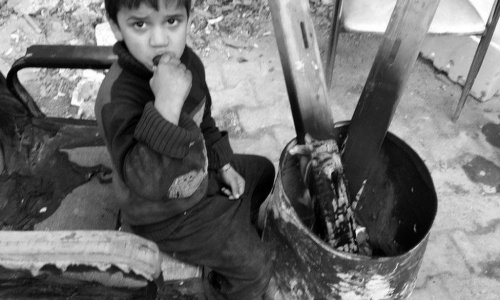While most of Shekhawati’s havelis have crumbled and remain abandoned, a small window into the world of these painted mansions is being preserved.
A former home of opulence
Forgotten in the barren landscapes of Rajasthan’s Thar Desert, the Shekhawati region was once home to the unabashed opulence of India’s billionaires. Today, many of the billionaires’ grand havelis (mansions) are crumbling – the fading frescoes marking the only vestiges of the area’s vanished glory. (Credit: Neelima Vallangi)
Drenching the dusty towns in colour
With paintings covering nearly every inch of the grand havelis, the towns and villages of Shekhawati encompass the world’s largest concentration of magnificent frescoes in a single region. To protect these once grand estates from crumbling further, two districts within Shekhawati have banned the sale of the havelis to anyone who could harm their heritage look. Their aim is to conserve and promote Shekhawati as a tourist destination. (Credit: Neelima Vallangi)
The rise of merchant success
Founded by the eponymous Rajput chieftain Rao Shekha in the late 15th Century, Shekhawati prospered immensely at the turn of the 19th Century. The region reduced taxes to lure merchants and diverted all caravan trade from the nearby commercial centres of Jaipur and Bikaner. Merchants belonging to the Marwari and Bania community, a renowned ethnic trading group in India, moved into Shekhawati from the surrounding towns, and amassed great wealth through a flourishing trade in opium, cotton and spices. Modest merchant homes started giving way to grand mansions by the end of the 19th Century. (Credit: Neelima Vallangi)
Where wealth melds with artistic expression
When trade moved from caravan routes to sea routes and railways in the 1820s, Rajasthan’s trade centres were on a steady decline. However, the enterprising merchants of Shekhawati followed the money trail and moved to the fledgling port towns of Bombay and Calcutta on the Indian coast, sending back enormous amounts of money to their homes in Shekhawati and thus heralding an era of uniquely painted havelis that acted as lavish displays of wealth. (Credit: Neelima Vallangi)
Many courtyards and elaborate designs
Most Havelis were built in a similar architectural style – usually two storied buildings with two to four open courtyards arranged within a rectangular block. Each courtyard and the corresponding rooms were designated for specific purposes. The first courtyard after entering the house was for men and their business dealings, the second was for women and the other two were for cooking and animal stables. But the merchants left no stone unturned in giving their mansions a distinct look, with ornately carved wooden entrances, pompous mirror work and the defining differentiator: ostentatious paintings depicting daily life and mythology. (Credit: Neelima Vallangi)
Frescoes adorn every surface
Inspired by the 17th-century ochre frescoes introduced by the Rajput kings of Jaipur in Amer Fort, the merchants commissioned intricate paintings on every inch of the mansion walls – including exteriors, interiors, ceilings and even the spaces under the arches and eaves. Scenes from the ancient Hindu epics of Mahabharata and Ramayana – along with plenty of decorative floral designs and patterns – were the most common motifs featured in the frescoes for a large part of the 19th Century. (Credit: Neelima Vallangi)
A wide range of colours
Painters were first commissioned from the city of Jaipur, but after noticing a rising interest in frescoes, members from the potter community in Shekhawati started learning the craft and created a proliferation of distinct styles across different villages. It is not entirely clear if the artists had full reign over the designs or if they were given specific instructions in choosing patterns and mythological scenes.
Before the mid-19th Century, traditional pigments made from minerals and vegetables dominated the colour palette, with intense shades of reds, maroons, indigo, lapis lazuli and copper blue along with bright yellow supposedly made out cow’s urine. Starting 1860s, synthetic pigments came into use, which were cheaper and offered a wide range of new colours. (Credit: Neelima Vallangi)
Mixing myth and the modern
By the early 20th Century, the frescoes began depicting European influences and modern advancements – recollections from what the well-travelled merchants had seen in the big cities. In some rare cases, the painters were sent to observe and recreate the scenes. Among the traditional motifs, there are frescoes of Queen Elizabeth, Jesus, cherubs, steam engines and gramophones, as well as whacky creations mixing mythology with modern inventions, such as Hindu gods in chauffeur-driven cars (pictured). (Credit: Neelima Vallangi)
Abandoned for good
The havelis and frescoes of Shekhawati blossomed until the early 20th Century; after which, the rich business tycoons left the desert wasteland for better opportunities in bustling metropolises like Bombay and Calcutta and even abroad. After the trade moved elsewhere, there was little development in the arid lands of Shekhawati, and the havelis were abandoned for good.
Some of the biggest names in the Indian and global business scene today – including the likes of the steel baron Laxmi Mittal, Kumar Birla of Aditya Birla Group, pharmaceutical billionaire Ajay Piramal and Nepal’s only billionaire, Binod K Chaudhary, had their origins in the villages of Shekhawati. In fact, according to Forbes, almost 25% of India’s 100 richest were from Shekhawati. (Credit: Neelima Vallangi)
The high cost of upkeep
By the 1950s, the thriving towns that had raised these billionaires were falling into steady despair. Selling or renovating these rural family bungalows – some of which could house up to 50 families at once – is a difficult job. The cost of upkeep is high and many of the properties, usually shared between multiple heirs, are embroiled in legal disputes. But since havelis are private properties, the government cannot do much to preserve them. (Credit: Neelima Vallangi)
A new life for the Shekhawati mansions
Luckily, the beauty and cultural significance of these painted havelis is not lost on everyone. In 1999, French artist Nadine Le Prince bought the 1802-built Nand Lal Devra Haveli (now called Nadine Le Prince Cultural Centre) and painstakingly restored it to its former glory in the town of Fatehpur. In the neighbouring towns of Dunlod and Nawalgarh, Seth Arjun Das Goenka Haveli and Shri Jairam Dasji Morarka’s family mansions have also been restored and turned into museums for public viewings. A few other havelis-turned-museums are scattered in the hinterlands of Shekhawati, and some like Malji ka Kamra, Koolwal Kothi and Castle Mandawa have been turned into heritage hotels.
While some of the havelis may crumble and fall apart – their glory lives on in others. (Credit: Neelima Vallangi)
(BBC)










www.ann.az
Follow us !











